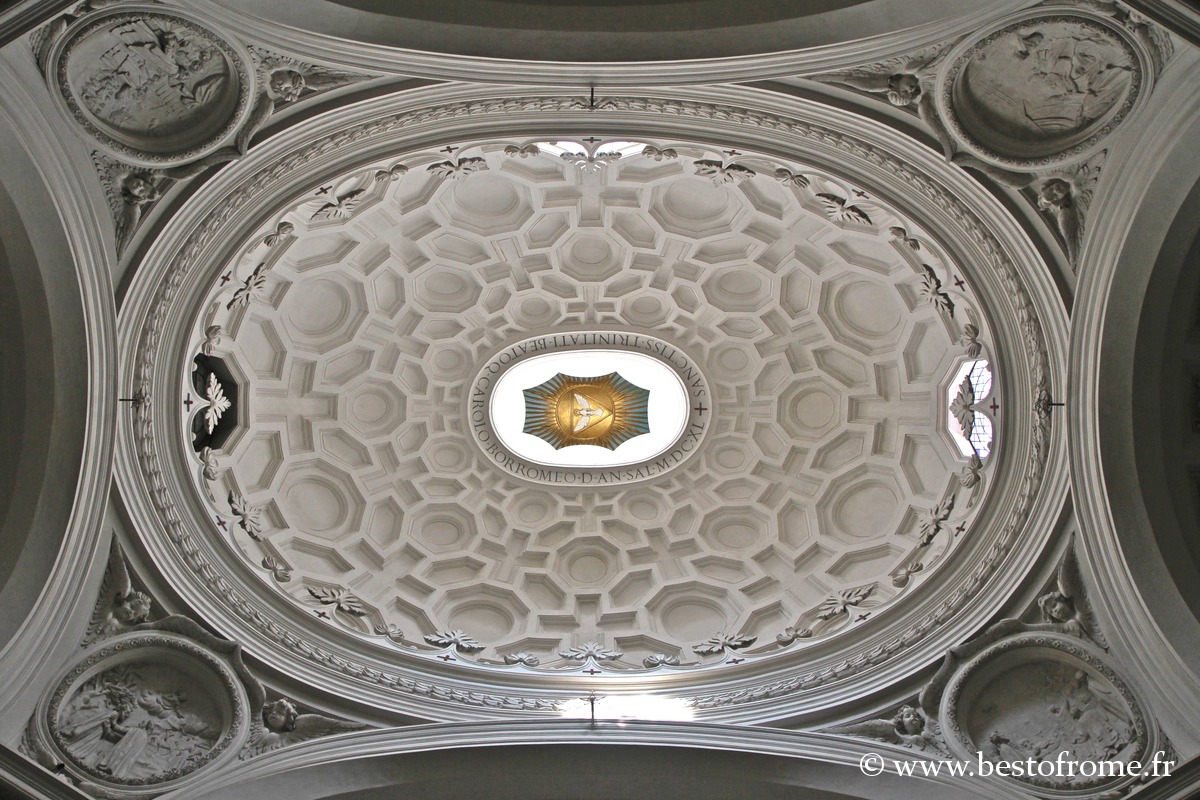A Master of Baroque in Rome
Francesco Borromini, born Francesco Castelli (September 25, 1599 – August 2, 1667), was an Italian architect from Swiss Ticino.
Alongside his contemporaries Gian Lorenzo Bernini (Bernini) and Pietro da Cortona, he shaped part of the current city, the Baroque Rome often described as exuberant, developed during the Counter-Reformation.
Influenced by Michelangelo and ancient architecture, Borromini developed an original architectural language, playing with the manipulation of classical, geometric, and symbolic forms. His understanding of architectural structures appears to have been more profound than that of his contemporaries, Bernini and Cortona, whose initial training was primarily linked to other artistic disciplines.
Borromini’s Career in Rome and San Carlino
Borromini began his career at 19 as a stonemason under Carlo Maderno, who was in charge of the construction site of St. Peter’s Basilica in Rome. He distinguished himself there with a brilliant talent for drawing, designing original curves that created striking light contrasts.
At the age of 35, after years of working in the shadow of great masters, he embarked on the ambitious project of San Carlino, confident in his talent. He offered to work for free for the Trinitarian Community, a poor order, to build a church on the condition of having no constraints.
The construction of San Carlo alle Quattro Fontane began in 1634 and was completed in 1665, including the convent buildings, a cloister, and a wing on Via del Quirinale with the chapter house. The main church was built starting in 1638 above a crypt, with the facade and bell tower completed between 1670 and 1677 by Borromini’s nephew, Bernardo.
Professional Relationships and Rivalries
After some collaborations with Bernini, notably at St. Peter’s and the Barberini Palace, their relationship deteriorated, giving rise to a rivalry that significantly impacted Borromini’s career. Some historians believe that Bernini, aware of his former collaborator’s talent, may have attempted to hinder his rise.
He briefly rose to prominence under the pontificate of Innocent X, but upon the latter’s death in 1655, he lost the Vatican’s favor and fell into deep depression. He resumed work on the façade of San Carlino only ten years later, then completed the Falconieri Chapel in the church of San Giovanni dei Fiorentini.
A Fragile Temperament and a Tragic End
Borromini’s temperament likely played a negative role in his career. Unlike Bernini, a skilled courtier, Borromini was melancholic and introverted. He suffered from nervous disorders and became particularly isolated toward the end of his life, withdrawing from certain projects.
He took his own life on August 2, 1667, by throwing himself on his sword after writing his will in a state of confusion. Shortly before his death, fearing that his rivals might appropriate his work, he had destroyed all his working drawings by fire.
Legacy and Posthumous Reception
Borromini’s influence remained limited, except for a few cases such as the Piedmontese architecture of Camillo-Guarino Guarini and, more broadly, certain achievements of late Baroque in Northern Europe, where his style was occasionally adopted alongside those of Bernini and Cortona.
However, from the late 19th century, his work sparked renewed interest and was gradually recognized for its architectural inventiveness.
Borromini’s Works in Rome
Borromini’s Main Works
- San Carlo alle Quattro Fontane
In 1634, Borromini received his first major independent commission to design the church, cloister, and monastic buildings of San Carlo alle Quattro Fontane (also known as San Carlino). The church was built from 1638 to 1641 and dedicated in 1648 to San Carlo Borromeo. Though small, it is considered a masterpiece of Roman Baroque. - Oratory of the Philippines
After the reconstruction of the church of Santa Maria in Vallicella (known as Chiesa Nuova) in the late 16th century, the Oratorians hired Borromini starting in 1637 to build the palace and oratory adjacent to the church. - Sant’Ivo alla Sapienza
From 1640 to 1650, he worked on the design of the church of Sant’Ivo alla Sapienza and its courtyard, near the Palazzo della Sapienza of the University of Rome. He had been initially recommended in 1632 by his then-supervisor at the Palazzo Barberini, Gian Lorenzo Bernini. The narrow site posed a challenge for the architect.
Other Works and Contributions by Borromini
- Sant’Agnese in Agone
Borromini was one of the architects involved in the construction of the church of Sant’Agnese in Agone in Rome. However, some of his design intentions were altered by subsequent architects, resulting in a building that, unfortunately, reflects a mix of different approaches. - Interior of the Basilica of St. John Lateran and Lateran Baptistery (frieze)
- Palazzo Spada (Trompe-l’oeil perspective gallery)
- Palazzo Barberini (upper floor windows and oval staircase)
- Sant’Andrea delle Fratte
- Palazzo di Propaganda Fide (side façade, chapel)
- Santa Maria dei Sette Dolori
- Oratory of San Giovanni in Oleo (restoration) and nearby San Giovanni a Porta Latina (interior remodeling)
- Saint John the Baptist of the Florentines (apse)
- Palazzo Giustiniani (with Carlo Fontana)
- Façade of the Palazzo Falconieri
- Santa Lucia in Selci (restoration)
- St. Peter’s Basilica (parts of the Chapel of the Blessed Sacrament, possibly parts of the baldacchino)
Borromini Itinerary in Rome: Map
If you see this after your page is loaded completely, leafletJS files are missing.











